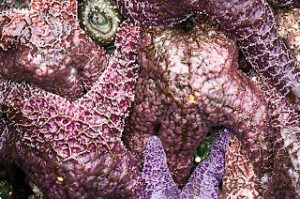By Eleanor Hines, North Sound Baykeeper and Lead Scientist. Originally published in Cascadia Weekly, January 23rd, 2019. Also see our 2020 piece on why we’re calling it “Community Science” now instead.
Last spring, I trekked to the early-morning, calm shores of the Cherry Point Aquatic Reserve just south of Birch Bay, alongside 15 inquisitive students, retirees and families with children. I was amazed this many people showed up on a Saturday. We ventured together onto the cobble beach armed with clipboards, data sheets, field guides, and an appreciation for the Salish Sea. We sought to observe and record information on the vast diversity of plants and animals that make their homes in the intertidal zone—the area of the shoreline that’s underwater at high tide and exposed during low tides.
Most of these people had little to no experience in scientific data collection—so what drew them here on a weekend morning?
With numerous warning signs about the declining health of Puget Sound, and funding shortfalls in natural resource agencies like the Environmental Protection Agency and the State Department of Ecology, keeping a pulse on our local waters is increasingly up to the very people these agencies serve. This handful of volunteers, or citizen scientists, are stepping up to the task.
 There are extensive gaps in our understanding of organisms living in the Salish Sea and how pollution affects them, especially on a planet facing the unpredictability of climate change and ocean acidification. If a major oil spill or other catastrophe struck Puget Sound tomorrow, we wouldn’t even have enough information to fully understand the extent of the damage, let alone fix it all.
There are extensive gaps in our understanding of organisms living in the Salish Sea and how pollution affects them, especially on a planet facing the unpredictability of climate change and ocean acidification. If a major oil spill or other catastrophe struck Puget Sound tomorrow, we wouldn’t even have enough information to fully understand the extent of the damage, let alone fix it all.
In order to tackle the problems in the Salish Sea—like declining Chinook salmon and orca populations, or increasing levels of pollutants draining into it from roads after rain—we need to get a sense of the bigger patterns at play. Citizen scientists, like those volunteers last spring, can help collect information critical to protecting salmon, local fisheries, endangered orca whales, important scenic and recreational areas, and more.
To fix a problem, we must first define it.
Public funding for monitoring such patterns has always been extremely tight. And it’s only gotten tighter as the funding that exists is constantly at risk of drying up. On top of this, hiring freezes and longtime staff retiring without replacements keep agencies hard-pressed to do what they were set up to do.
The Puget Sound Partnership estimates that filling gaps in monitoring key indicators of the Salish Sea’s health, like migratory bird populations or the amount of smaller fish that Chinook salmon eat, could cost $12.5 million annually. Work done by citizen scientists could help bring down this shocking figure. Citizen scientists, being equal parts “citizen” and “scientist,” are participating in research that informs public policy.
And there’s good news: anyone can be a citizen scientist!
Being a citizen scientist doesn’t just mean someone is casually interested in science. They bring their status as a citizen—as a voter—to the scientific process, putting themselves at the heart of making the big changes needed to create resiliency in ourselves and in the environment we all rely on.
Two years ago, RE Sources and the Whatcom MRC formed the North Sound Stewards, a program in which citizen scientists receive training to build a reliable stock of data on various plants and animals from local beaches and tidal zones. The goal is to inform Salish Sea recovery and protection efforts. For example, RE Sources is working with the Washington Department of Natural Resources to use citizen science data in updated management and oil spill response plans.
“We need to make sure our elected officials and the public have both the information and motivation to act. Who better to help provide these than a voter who has also helped watch over our precious ocean ecosystems?” said Chris Brown, Whatcom Marine Resource Committee (MRC) member and citizen scientist.
To learn more or to become a citizen scientist, visit our citizen science page.
